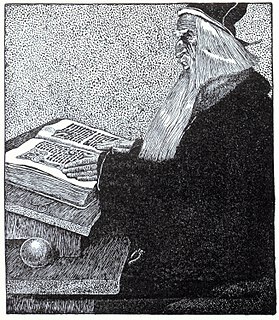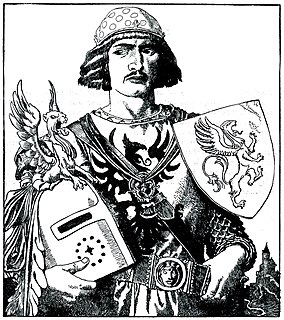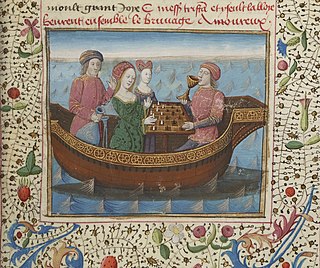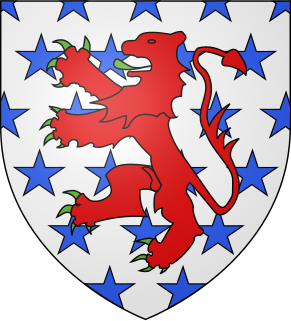
Excalibur is the legendary sword of King Arthur, sometimes also attributed with magical powers or associated with the rightful sovereignty of Britain. It was associated with the Arthurian legend very early on. Excalibur and the Sword in the Stone are in some versions said to be different, though in other incarnations they are either the same or at least share their name. In Welsh, it is called Caledfwlch; in Cornish, Calesvol ; in Breton, Kaledvoulc'h; and in Latin, Caliburnus. Several similar swords and other weapons also appear in this and other legends.

King Arthur was a legendary Celtic Briton who according to medieval histories and romances, was leader of the Celtic Britons in battles against Saxon invaders of Britain in the late 5th and early 6th centuries. Details of Arthur's story are mainly composed of Welsh mythology, English folklore and literary invention and there is disagreement and discussion about his historicity. The sparse historical background of Arthur is gleaned from various sources, including the Annales Cambriae, the Historia Brittonum, and the writings of Gildas. Arthur's name also occurs in early poetic sources such as Y Gododdin.

Merlin is a mythical figure prominently featured in the legend of King Arthur and best known as an enchanter or wizard, among his various other roles. His usual depiction, based on an amalgamation of historic and legendary figures, was introduced by the 12th-century British author Geoffrey of Monmouth. It is believed that Geoffrey combined earlier tales of Myrddin and Ambrosius, two legendary Briton prophets with no connection to Arthur, to form the composite figure called Merlinus Ambrosius . Geoffrey's rendering of the character became immediately popular, especially in Wales. Later writers in France and elsewhere expanded the account to produce a fuller image, creating one of the most important figures in the imagination and literature of the Middle Ages.

Gawain, also known as Gawaine or Gauwaine, among other forms and spellings, is a character in Arthurian legend, in which he is King Arthur's nephew and a Knight of the Round Table. The prototype of Gawain is mentioned under the name Gwalchmei in the earliest Welsh sources. He has subsequently appeared in many Arthurian stories in Welsh, Latin, French, English, Scottish, Dutch, German, Spanish, and Italian, notably as the protagonist of the famous Middle English poem Sir Gawain and the Green Knight. Other tales featuring Gawain as the central character include De Ortu Waluuanii, Diu Crône, Ywain and Gawain, Golagros and Gawane, Sir Gawain and the Carle of Carlisle, L'âtre périlleux, La Mule sans frein, La Vengeance Raguidel, Le Chevalier à l'épée, The Awntyrs off Arthure, The Greene Knight, and The Weddynge of Syr Gawen and Dame Ragnell.

Lancelot du Lac, also written as Launcelot and other variants, is a character in some versions of Arthurian legend, where he is typically depicted as King Arthur's close companion and one of the greatest Knights of the Round Table. In the French-inspired Arthurian chivalric romance tradition, Lancelot is the orphaned son of King Ban of the lost Kingdom of Benwick, raised in the fairy realm by the Lady of the Lake. A hero of many battles, quests and tournaments, and famed as a nearly unrivalled swordsman and jouster, Lancelot becomes the lord of the castle Joyous Gard and personal champion of Arthur's wife Queen Guinevere. But when his adulterous affair with Guinevere is discovered, it causes a civil war that is exploited by Mordred to end Arthur's kingdom.

In the Matter of Britain, Igraine is the mother of King Arthur. Igraine is also known in Latin as Igerna, in Welsh as Eigr, in French as Ygraine, in Le Morte d'Arthur as Ygrayne—often modernised as Igraine or Igreine—and in Parzival as Arnive. She becomes the wife of Uther Pendragon, after the death of her first husband, Gorlois.

Sir Galahad, sometimes referred to as Galeas or Galath, among other versions of his name, is a knight of King Arthur's Round Table and one of the three achievers of the Holy Grail in Arthurian legend. He is the illegitimate son of Sir Lancelot du Lac and Lady Elaine of Corbenic and is renowned for his gallantry and purity as the most perfect of all knights. Emerging quite late in the medieval Arthurian tradition, Sir Galahad first appears in the Lancelot–Grail cycle, and his story is taken up in later works, such as the Post-Vulgate Cycle, and Sir Thomas Malory's Le Morte d'Arthur.

The Lady of the Lake is a name or a title used by several either fairy or fairy-like but human enchantresses in the Matter of Britain, the body of medieval literature and mythology associated with the legend of King Arthur. They play pivotal roles in many stories, including providing Arthur with the sword Excalibur, eliminating Merlin, raising Lancelot after the death of his father, and helping to take the dying Arthur to Avalon. Different sorceresses known as the Lady of the Lake appear concurrently as separate characters in some versions of the legend since at least the Post-Vulgate Cycle and consequently the seminal Le Morte d'Arthur, with the latter describing them as a hierarchical group, while some texts also give this title to either Morgan or her sister.

The Knights of the Round Table are the knights of the fellowship of King Arthur in the literary cycle of the Matter of Britain. First appearing in literature in the mid-12th century, the Knights are an order dedicated to ensuring the peace of Arthur's kingdom following an early warring period, entrusted in later years to undergo a mystical quest for the Holy Grail. The Round Table at which they meet is a symbol of the equality of its members, who range from sovereign royals to minor nobles.
The Queen of Orkney, today best known as Morgause and also known as Morgawse and other spellings and names, is a character in later Arthurian traditions. In some versions of the legend, including the seminal text Le Morte d'Arthur, she is the mother of Gawain and Mordred, both key players in the story of King Arthur and his downfall. Mordred is the offspring of Arthur's accidental incest with Morgause, the king's estranged half-sister. She is furthermore a sister of Morgan le Fay and the wife of King Lot of Orkney, as well as the mother of Gareth, Agravain, and Gaheris, the last of whom murders her.

In Arthurian legend, the Siege Perilous is a vacant seat at the Round Table reserved by Merlin for the knight who would one day be successful in the quest for the Holy Grail. The English word "siege" originally meant "seat" or "throne" coming from the Old French sege ; the modern military sense of a prolonged assault comes from the conception of an army "sitting down" before a fortress.

Gaheris is a knight of the Round Table in the chivalric romance tradition of Arthurian legend. A nephew of King Arthur, Gaheris is the third son of Arthur's sister or half-sister Morgause and her husband Lot, King of Orkney and Lothian. He is the younger brother of Gawain and Agravain, the older brother of Gareth, and half-brother of Mordred.
Robert de Boron was a French poet of the late 12th and early 13th centuries, notable as the reputed author of the poems Joseph d'Arimathie and Merlin. Although little is known of him apart from the poems he allegedly wrote, his works and subsequent prose redactions of them had a strong influence on later incarnations of the Arthurian legend and its prose cycles, particularly through their Christian back story for the Holy Grail.

Sir Agravain is a Knight of the Round Table in Arthurian legend, whose first known appearance is in the works of Chrétien de Troyes. He is the second eldest son of King Lot of Orkney with one of King Arthur's sisters known as Anna or Morgause, thus nephew of King Arthur, and brother to Sir Gawain, Gaheris, and Gareth, as well as half-brother to Mordred. Agravain secretly makes attempts on the life of his hated brother Gaheris since the Vulgate Cycle, participates in the slayings of Lamorak and Palamedes in the Post-Vulgate Cycle, and murders Dinadan in the Prose Tristan. In the French prose cycle tradition included in Thomas Malory's Le Morte d'Arthur, together with Mordred, he then plays a leading role by exposing his aunt Guinevere's affair with Lancelot, which leads to his death at the hands of Lancelot.
This is a bibliography of works about King Arthur, his family, his friends or his enemies. This bibliography includes works that are notable or are by notable authors.

The Lancelot-Grail, also known as the Vulgate Cycle or the Pseudo-Map Cycle, is an early 13th-century French Arthurian literary cycle consisting of interconnected prose episodes of chivalric romance in Old French. The cycle of unknown authorship, presenting itself as a chronicle of actual events, retells the legend of King Arthur by focusing on the love affair between Lancelot and Guinevere as well as the religious quest for the Holy Grail, expanding on the works of Robert de Boron and Chrétien de Troyes.

The Post-Vulgate Cycle, also known as the Post-Vulgate Arthuriad, the Post-Vulgate Roman du Graal or the Pseudo-Robert de Boron Cycle, is one of the major Old French prose cycles of Arthurian literature from the early 13th century. It is considered essentially a shortened rewriting of the earlier Vulgate Cycle, with much left out but also much added, including characters and scenes from the Prose Tristan.

The Prose Tristan is an adaptation of the Tristan and Iseult story into a long prose romance, and the first to tie the subject entirely into the arc of the Arthurian legend. It was also the first major Arthurian prose cycle commenced after the widely popular Lancelot-Grail, which influenced especially the later portions of the Prose Tristan.

Galehaut is a half-giant knight in the Arthurian legend. He is most prominent within the Lancelot-Grail prose cycle where he is a noble enemy turned an ally of King Arthur as well as an inseparable friend of Arthur's champion Lancelot. The figure of Galehaut should not be mistaken with Lancelot's son, Galahad, and some other similarly named characters.
Guiomar is the best known name of a character appearing in many medieval texts relating to the Arthurian legend, often in relationship with Morgan le Fay or a similar fairy queen type character.
















